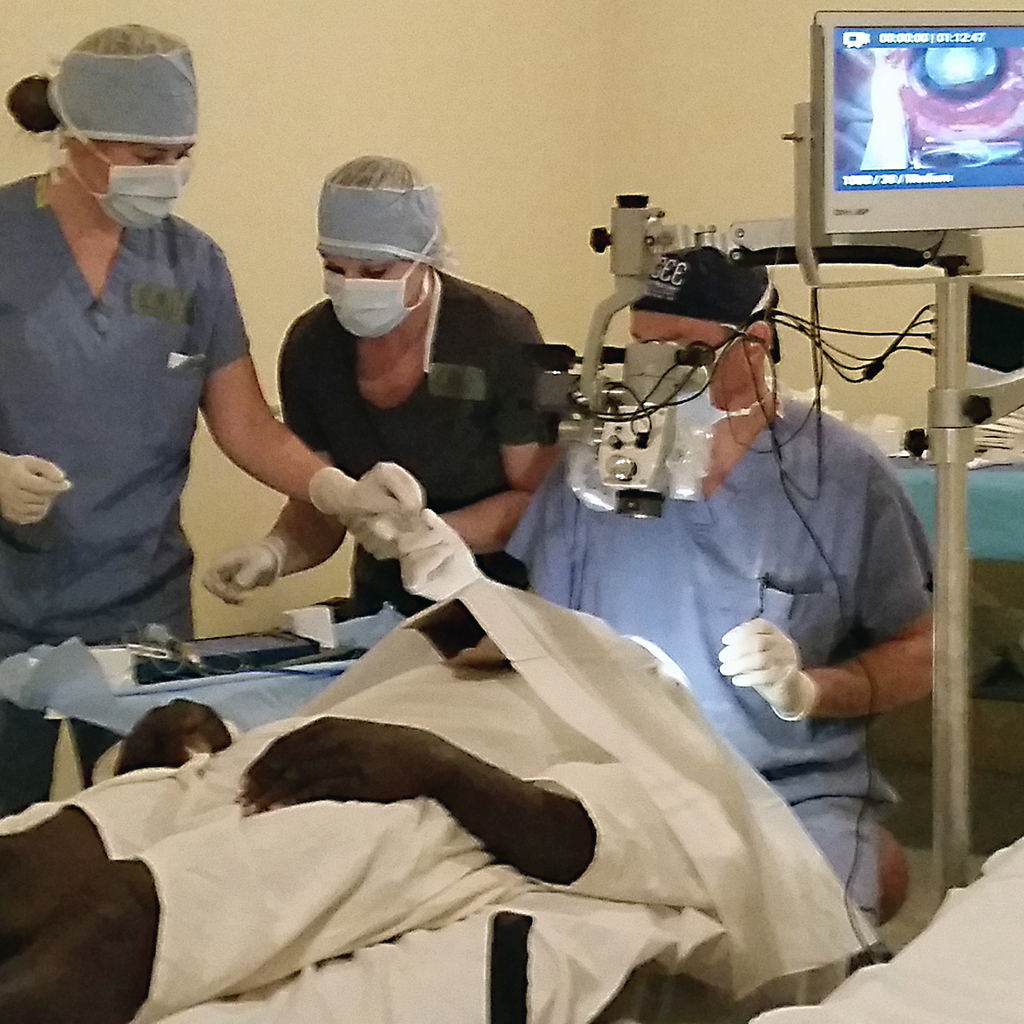This is the second part ( continuation ) of MSICS suggestions after the SEE course.
After hydrodissection / hydrodelineation and a capsulotomy, if possible spin the nucleus before you rotate it up through pupil into A.C. If unable to spin then just rock nucleus east / west and north/ south. Free it up. You need a large pupil as you must identify the edge ( equator ) of the nucleus so you can lift / rotate nucleus up into A.C. You can use a cannula attached to the viscoelastic or a Kuglen hook or a Sinskey hook or whatever you like to get around ( behind ) equator and lift / dial nucleus.. You can also use viscoelastic to gentle push iris behind equator of the nucleus ( bed-sheeting ) without touching iris with your cannula. This can be especially helpful inferiorly. Go slow.
Before attempting to extract nucleus, check / sweep the wound. Be sure no hang-ups. You need wide open endothelium entrance. Wound construction is such the endothelium opening is 2 mm larger than scleral external opening. In other words you want a funnel or pyramid shaped wound construction. I use a 7 mm scleral opening. With younger patients or with dense, white, mature cataracts the incision sometimes can be smaller.
Once you get nucleus into A.C. then you are ready to extract nucleus from eye. Most surgeons use an irrigating vectis ( loop ). You must protect the endothelium and therefore I put viscoelastic behind the nucleus ( between nucleus and pupil / iris ), in front of the nucleus ( between nucleus and endothelium ) and also on the iris surface right where the corneal endothelium wound starts. In other words I put viscoelastic at 12 o’clock in A.C. to keep iris back when I am removing nucleus with vectis. You do not want iris prolapse as you remove nucleus. Keep the iris back with the viscoelastic.
As you remove the nucleus from the eye , you want several things happening at the same time: #1. Have the A.C. irrigation ( flow ) on #2. Pressure down gently on posterior lip of scleral (external ) wound with irrigating vectis, #3. Rotate globe downward ( away from you ). This is highly important. Many Indian ophthalmic surgeons put in superior rectus bridle suture mainly so they can strongly rotate globe downward as they extract nucleus. If you are sitting temporally then obviously you need to rotate / push eye nasally. You can use 0.12 forceps to rotate the globe downward. Sometimes you can just tell the patient to look down which often helps. This enables the loop to be in the best position ( angle ) to open the tunnel and helps the nucleus to come out.
In the A.C., the loop is carefully advanced under the upper pole ( equator ) of the nucleus. Be careful not to have loop go under the iris as an iris tear / iridodialysis can occur. Don’t sandwich iris between loop and nucleus. Bad news. Most surgeons advance irrigating vectis to the lower edge ( equator ) of the nucleus. Do not creep up ( scoop ) as you extract the nucleus. Do not rub /scrape the nucleus on the endothelium.
If nucleus gets stuck in corneosclera wound, you can try to rotate out or disassemble / debulk with 30 G needle / cystitome. Sometimes gently pressing on posterior lip of wound can help. You can redeposit in A.C. and try again / start over. Be gentle to the endothelium.
There are alternatives ways to remove the nucleus. Dr. A. Hennig in Nepal popularized using a bent 30 G needle ( fishhook) to extract the nucleus.. Dr. Blumenthal pioneered an anterior chamber maintainer. Dr. Kansas / McIntyre / Alfonso used a spatula, bisector or trisector , and a serrated forceps to remove the divided nuclear fragments ( phaco-fracture ).
Some surgeons prefer a quite soft eye /orbit pre-op and use still use a super-pinkie to have a soft eye /orbit. You can have the patient gently hold rolled up socks in a glove ( or whatever ) on the eye for 10 minutes before surgery.
Many surgeons do a lot of their maneuvers through an eight o’clock paracentesis site ( parallel to the iris ) . The paracentesis should be large enough to accept Simcoe I + A unit. One can actually rotate the following / trailing haptic into the posterior chamber through the paracentesis site. Put the push-pull hook into the crotch of the IOL. I would encourage you again to look at You-Tube video examples of MSICS.
Some surgeons routinely leave an air bubble in A.C. at the end. Some surgeons simply irrigate / flush out the viscoelastic rather than trying to aspirate. When in doubt with your wound construction — suture. If vitreous loss occurred, I start patient on an oral floroquinolone. immediately.
Well that’s my suggestions from the SEE course. I would encourage everyone to take a course, look at the videos, do your homework prior to “ having a go “ with MSICS in a developing world setting. Previously there have been MSICS courses at the Academy.
Peace ~ Baxter

